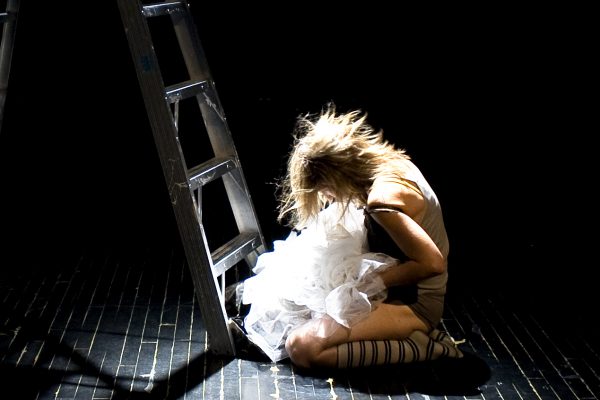It seems the momentum of Peggy Baker’s thirty-five-year dance career is still gathering speed. The recent tour of Peggy Baker Dance Projects saw a different program of works performed in each of the three Canadian cities visited, including four premieres in total. Toronto was blessed with a program of two well-known and adored pieces choreographed by Peggy Baker shouldered by two new works. “Yang”, originally a solo but reconfigured as a duet was danced by two of Peggy Baker’s protégé dancers Sahara Morimoto and Louis Laberg-Côté, and a work gracefully withstanding the test of time, “Brahms Waltzes” was sublimely danced by Jessica Runge. “A Woman By A Man” choreographed by the ever-satirical James Kudelka concluded the programme on an amusing note and was best critiqued by Kudelka himself who admitted that in the race to keep up with the music of Dmitri Shostakovich, “the dead, white man probably won”. Nevertheless the audience was won over by the wit and dynamism of the piece. Of this varied program of works, it was the enigmatic “Portal”, a solo piece danced and choreographed by Peggy Baker, that captured my focus.
There are many reasons that the choreographer might chose to create and perform a solo work: a returning to home — one’s own body is the natural beginning for a choreographer’s experimentation; for the sake of clarity of one’s ideas, since solo work requires neither translation onto another body, nor to take root in another’s mind — and, lest it be said, as a measure to face the economic realities that often impinge on a choreographer’s ability to create new dance works. It is, however, also true that once you have seen a truly great solo, you will never forget that dancer. For those acquainted, each will recall the euphoric sensation at seeing the performance that cemented the place of that dancer dancing that part in their heart forever, and the intimacy of the solo needs no further recommendation. Acclaimed modern dance artist Peggy Baker brings her long history of creating remarkable dances to light in “Portal”, a solo that transcends the solo.
It has been observed that Baker has rarely been a soloist in the formal sense, nor does she actually consider “Portal” to be a solo work. From her perspective, it is a duet between she and the light, and upon witnessing the visionary lighting by Marc Parent, this metaphor for existence lingers with me. Despite the spareness of collaboration in the piece, Baker — a proponent of live music who frequently works with some of Canada’s finest musicians — did not approach the creation of this work with a mindset of anti-collaboration for the sake of bringing dance itself into focus. What need would there be? When Baker is on stage, her dance is your captor. Baker has a more intuitive methodology behind her choice to create a solo dance in silence: to enliven the audience members’ awareness of their physicality, which has surprising effects.
The silence washes a heavy intimacy over the theatre that belies the depth of the stage and regular rows of tiered audience seats, and senses tingle for the darkness makes them eager. The dance takes the form of the dancer, Baker, momentarily lit, and then plunged into pitch darkness again. In the first instance, a sharp beam opens up the stage, her face contorts with anxiety, turned skywards into the drenching chamois light. This body has dance written into its skin; a long history of expression inscribes every sinewy muscle. Aging has not dared encroach on her still dreamily elastic extension, but has perhaps enhanced the drama running through her supple, kinetic hands and feet. If gravity left us, it seems those feet would remain firm to the floor. But such groundedness takes effect through oppositional lightness, fingers flying with a freedom of motion Baker commands.
With no music to manipulate the emotions of the audience, like an organism, her dance transmutes in the perceptions of the audience, and stories grow from what her body merely suggested, and slowly my curiosity is drawn to the next illuminated epithet. Without cognition, my senses are wound around Baker’s elusive movement. When she breathes, I realise I was holding mine. Arms waving crazily like a colossal tree dashed by a storm, she tears through light, only to be swallowed by darkness. Tormented by the pitch darkness that steals her again and again, I hunger for the sallow shards of light to expose her bearing, while heeding the dying impressions still incandescent before my eyes.
The dialogue between Baker and the light becomes even more obscure as she gradually slips from the focus of illumination; at one point, there are moments of light all around, and though she is given to none of them, she is obvious to us, centred and seemingly displaced at once.
I heard it murmured in the theatre, that perhaps Peggy Baker doesn’t exist at all, and wondered whether it was “just a dream”. The cloud of impressions formed by the afterglow in one’s consciousness tip one into a just-waking state; hazy, dreamlike memories still haunt the next moment as Baker is illuminated again. But what we “see” in the dark is no less part of the dance that what we “see” in the light …
Baker, also known for her acting prowess, is a skilled performer, and although her performance is emotive and honest, the dance does not degenerate into naked convulsions of the soul. A precise choreographer, the audience trusts her, and follows her through the darkness, and to the edge of madness. Yet in harmonious conclusion, Baker is remote, embraced by light, and “Portal” is a reminder that the great moments of transition in life are taken alone.
Tagged: Contemporary, Performance, ON , Toronto





